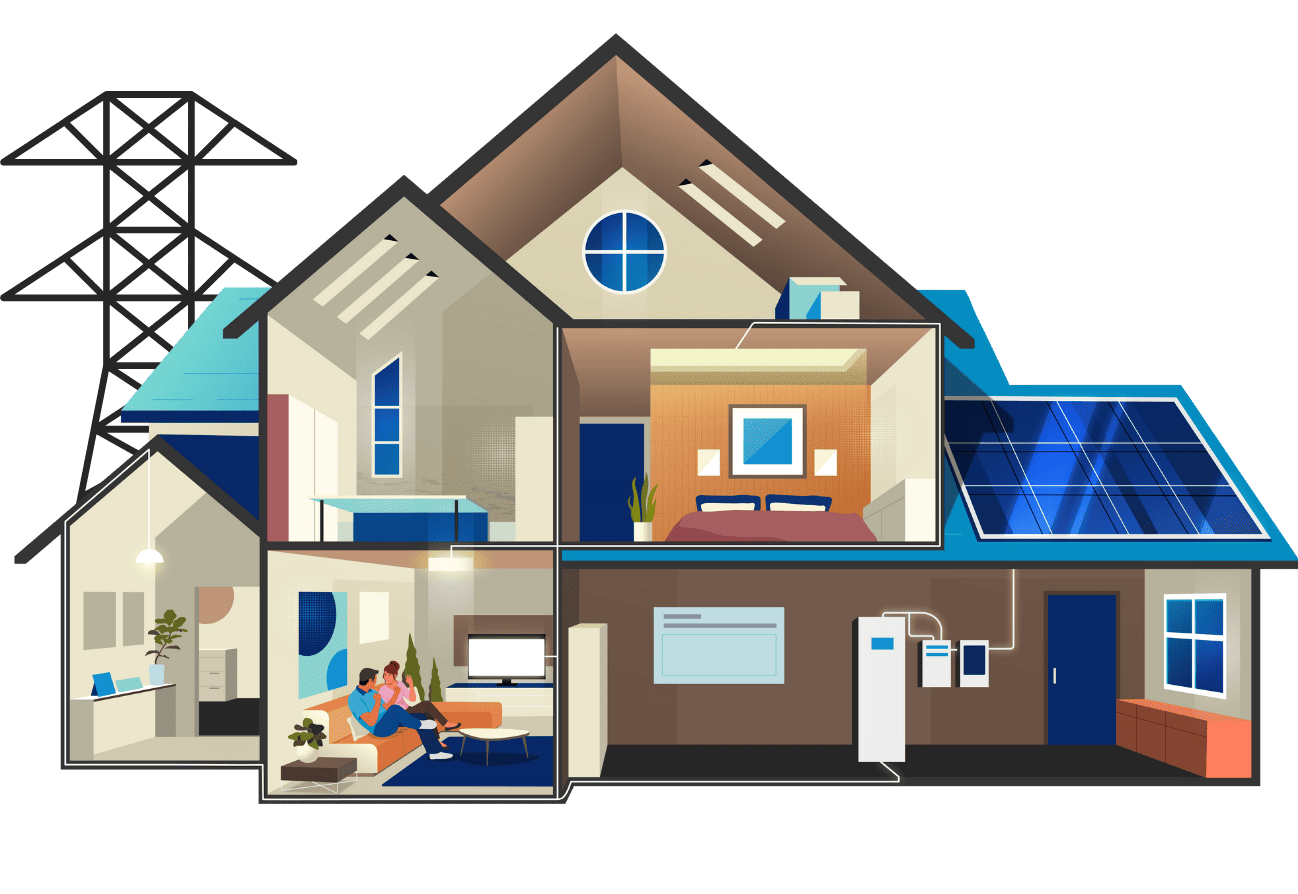How Does Solar Work?
Learn about how solar technology works and how to get started powering your home with clean energy.
The benefits of solar
Immediate Energy Savings
Slash electricity bills with solar! Financed systems reduce costs, tax credits cut upfront expenses, boosting ROI and putting money in your pocket. Go solar and save!
Avoided Utility Costs
California utilities hike rates relentlessly. Beat the surge with solar panels and home batteries. Slash reliance on costly peak-time electricity. Take control.
Backup Power
Power your home during outages! Solar panels can't do it alone. Add a battery system for backup, savings by shifting usage, and blackout resilience."
Immediate energy Ssavings
Slash electricity bills with solar! Financed systems reduce costs, tax credits cut upfront expenses, boosting ROI and putting money in your pocket. Go solar and save!
Avoided Utility Costs
California utilities hike rates relentlessly. Beat the surge with solar panels and home batteries. Slash reliance on costly peak-time electricity. Take control.
Boost Property Value
Solar boosts property value by offering energy efficiency and reduced bills. A sustainable home with solar appeal enhances resale potential. Invest wisely, elevate your property's worth.
Backup Power
Power your home during outages! Solar panels can't do it alone. Add a battery system for backup, savings by shifting usage, and blackout resilience."
How panels convert light into energy
Solar cells convert sunlight into energy through the photovoltaic effect. When sunlight hits the cells, photons release electrons, generating a flow of electricity. This clean, renewable energy can then power homes and businesses, contributing to a sustainable and eco-friendly future
- Absorption: Solar cells absorb sunlight.
- Electron Release: Photons release electrons in the cells.
- Electric Current: Electrons create an electric current.
- Usable Energy: Converted sunlight powers homes and businesses, offering clean, renewable energy for a sustainable future.
Build your own home energy hub
With solar panels and battery backup, homeowners can create their own energy hub, reducing reliance on the grid and ensuring uninterrupted power supply. Embrace sustainability while enjoying complete energy independence.

Solar Panels
The sun provides photons of light
that hit cells on a panel. If conductors
are attached to the positive and negative
sides of a cell, it forms an electrical
circuit. When electrons flow through
such a circuit, they generate electricity.
Solar Inverter
The electricity from the solar panels
makes its way to the inverter. The
inverter turns DC electricity (raw
electricity) into AC electricity
(usable electricity).
Battery Storage
The coupling of solar and battery
storage is needed because of the
reduced rates for solar production
under NEM 3.0. A solar system
must be properly sized and
balanced with storage to ensure excess
power in Spring and high-production
months doesn’t escape to the grid at
disconnected values.
AC Current
With a grid-tied system, the AC
electricity will supply your home
and its appliances first, as needed.
At any moment, if the home’s needs
are satisfied, excess electricity from
the system is automatically fed into
the grid, creating a retail credit with
the utility for those units of electricity.
The Power Grid
Grid-tied systems allow you to
send excess production to the
grid at the right times. Your smart
battery allows your to send excess
to the grid at the right time as well
as allows you to draw power from
the grid when needed.

Help Central CA build a better future
Solar power is key to a brighter future in Central California. Embrace sustainable energy, reduce environmental impact, and create jobs locally. By harnessing the abundant sunshine, we build resilience, cut emissions, and pave the way for a greener, economically thriving community. Make the choice for cleaner, more affordable energy today, and build a legacy of responsible living for tomorrow.
Create your own home power plant
Solar empowers you to create a personal power plant at home. Generate clean energy, reduce bills, and take control of your electricity. Build a brighter future with your own solar-powered home.
Avoid new utility rate hikes
Escape rising utility costs! With solar, lock in your energy rate, shielding yourself from future hikes. Invest today, save tomorrow, and take control of your financial energy future.
Solar power FAQs
1. Monocrystalline Solar Panels:
- Description: These panels are crafted from a single silicon crystal structure.
- Benefits: High efficiency and space-saving design.
- Considerations: Typically more expensive, but ideal for limited roof space.
2. Polycrystalline Solar Panels:
- Description: Constructed from multiple silicon crystals.
- Benefits: Cost-effective option with good efficiency.
- Considerations: Slightly lower efficiency compared to monocrystalline, but budget-friendly.
3. Thin-Film Solar Panels:
- Description: Made from various materials like amorphous silicon or cadmium telluride.
- Benefits: Flexible, lightweight, and suitable for various applications.
- Considerations: Less efficient than crystalline panels, but ideal for limited space and large-scale installations.
Choosing the Right Type:
- Consider Your Space: Monocrystalline panels are efficient in small spaces, while polycrystalline panels suit larger areas.
- Budget Concerns: Thin-film panels offer a cost-effective choice.
- Application Needs: Consider the specific requirements of your project or installation.
It’s crucial to weigh the benefits and considerations of each type based on your unique circumstances. Advances in solar technology continue to enhance efficiency and performance across all types of panels, ensuring a sustainable and tailored solution for every user.
To learn more about the different types of solar panels read our blog article Your Guide to the Best Types of Solar Panels.
Solar panels have a remarkable lifespan, typically ranging from 25 to 30 years. This longevity is attributed to the durability of the materials used in their construction, primarily crystalline silicon. During this period, solar panels experience a gradual decline in performance, with efficiency decreasing by about 0.5% to 1% per year.
Factors influencing the lifespan include the quality of materials, maintenance, and environmental conditions. High-quality panels, well-maintained and protected from extreme weather, may even exceed the 30-year mark.
To learn more about the different types of solar panels read our blog article How Long Do Solar Panels Last?
The time it takes to recoup the investment in solar panels, known as the payback period, varies based on several factors. On average, homeowners see a return on investment (ROI) within 5 to 10 years. This period is influenced by factors such as system cost, available incentives, energy consumption, and local electricity rates.
The upfront cost of solar panels includes installation, equipment, and other associated expenses. Government incentives, like federal tax credits and local rebates, can significantly offset these costs, speeding up the payback period. Additionally, solar panel prices have decreased over the years, making the initial investment more accessible.
Energy consumption plays a crucial role. Homes with higher energy usage benefit more from solar panels, as the savings on electricity bills contribute to a quicker payback. Similarly, regions with higher electricity rates expedite the return on investment.
Advancements in solar technology contribute to improved efficiency, further accelerating the payback period. Additionally, solar panels typically come with warranties lasting 20 to 25 years, ensuring long-term performance and durability.
If there have been any changes to the program or payment structures since then, it’s advisable to check the latest information on the official IRS website or consult with a tax professional for the most accurate and up-to-date details.
To learn more about the different types of solar panels read our blog article Solar Payback Calculator | Should I Go Solar?
While it is technically possible to install solar panels yourself, it’s a complex task that requires specialized knowledge and skills. Proper installation involves electrical work, structural considerations, and compliance with local regulations. One mistake could lead to inefficiencies, safety hazards, or even damage to your property.
Professional solar installation is recommended for several reasons:
- Safety: Working with electrical components poses risks. Professionals have the expertise to ensure safe installation, reducing the likelihood of accidents or injuries.
- Regulatory Compliance: Local building codes and regulations govern solar installations. Professionals are familiar with these requirements and ensure your system meets all standards.
- Optimal Performance: Proper alignment and placement of panels are critical for efficiency. Professionals assess your property to maximize solar exposure, optimizing energy production.
- Warranty Coverage: Many solar panels come with warranties that may be voided if not installed by certified professionals. Professional installation ensures warranty coverage and protection for your investment.
- Efficiency: Professionals have the experience to design and install systems that maximize energy production, providing a better return on investment over time.
While DIY projects can be rewarding, solar panel installation is a significant undertaking that is best left to professionals. Their expertise ensures a safe, efficient, and compliant installation, giving you peace of mind and the best possible performance from your solar investment. Consider consulting with local solar experts to discuss your specific needs and obtain professional installation services tailored to your home.
In a PPA, the solar provider owns and maintains the solar panels, and the homeowner agrees to purchase the electricity generated by the system. Since the homeowner doesn’t own the system in this arrangement, they may not qualify for the ITC.
However, tax laws can change, and it’s essential to check the latest regulations or consult with a tax professional to get the most accurate and up-to-date information based on your specific situation and the current tax laws.
California offers various rebates and incentives to promote solar adoption and sustainability. The Federal Investment Tax Credit (ITC) allows homeowners to claim a percentage of their solar investment as a tax credit. In California, the state’s Self-Generation Incentive Program (SGIP) provides rebates for installing energy storage systems alongside solar.
The California Solar Initiative (CSI) historically offered rebates based on the system’s performance. Although the CSI rebate program is closed for residential projects, some utility companies still provide incentives for commercial installations. Net Energy Metering (NEM) allows homeowners to receive credits for excess energy sent back to the grid.
Property Assessed Clean Energy (PACE) financing is available, allowing homeowners to finance their solar projects through property tax assessments. Additionally, the California Solar Initiative Thermal Program supports solar water heating installations.
The state’s Low-Income Home Energy Assistance Program (LIHEAP) provides financial assistance to low-income households, including support for solar installations. The Single-Family Affordable Solar Homes (SASH) program assists low-income homeowners with solar adoption.
Local utility companies may offer additional incentives, such as performance-based incentives or time-of-use rates that benefit solar users. It’s crucial to check with your utility provider for specific programs and incentives available in your area.
Navigating these incentives can be complex, so consulting with a qualified solar professional is recommended. They can guide you through available programs, help maximize your savings, and ensure you take full advantage of the financial benefits associated with going solar in California.
To learn more about the different types of solar panels read our blog article Solar Rebates & Incentives.
Schedule an in-person consultation today.
Take the first step towards powering your home with renewable energy by meeting in-person with one of our solar experts.

